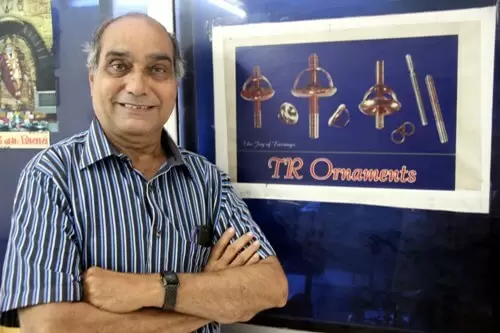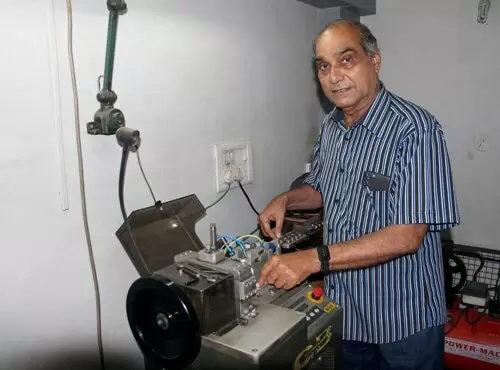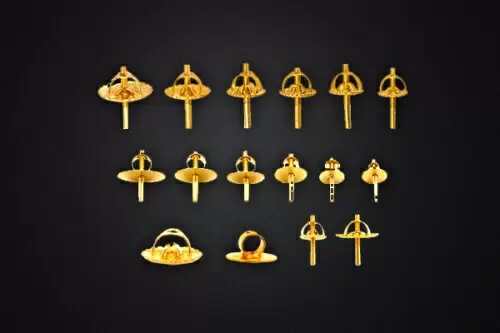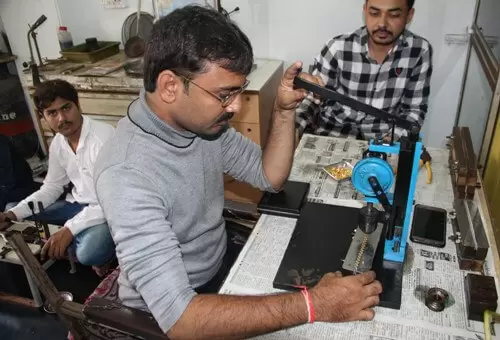He once sold soda in a bus stand, but unlocked the riches with a golden touch
08-August-2017
Vol 8 | Issue 22
At 15, he used to sell soda at a bus stand. By the time he was 30, he had a loan, an ailing wife, and three children to look after with no money in sight… but now, at 69, Mahesh Lodhiya runs a flourishing gold and diamond accessories business with an annual turnover of Rs. 90 lakh.
The self-proclaimed pioneer of self-locking earring clasp design in India, Mahesh comes from a family of goldsmiths but that’s not where he learnt his art.
 |
|
Mahesh Lodhiya developed self-locking earring clasps during the 1990s and there has been no looking back since (Photos: Chirag Chotaliya)
|
His father, Govind Keshavbhai Lodhiya, was one of four brothers and Mahesh lived in a joint family of 36 at Yavatmal in Maharashtra, where his father and uncles ran the small family jewellery business.
Their income was just about enough to feed the large family. There was no need, or room, for Mahesh in the family business – the fact that today he is a gold screw-set specialist, he says, can be attributed to destiny.
Living in the shadow of elder siblings (of nine children, he is the eighth), Mahesh never really had a proper income till the age of 35. “My father was a simple man,” he recalls. “He never thought of teaching his sons the business because my uncles used to run the entire show.”
Mahesh spent his youth doing odd jobs alongside his studies. “Father had a small partnership at a soda shop at the bus stand where we lived, and I used to help him sell soda,” Mahesh remembers. “I wasn’t even paid anything.”
He wasn’t really good at studies either and cleared class 10 only in the second attempt in 1965. In the same year, Govind and his brothers parted ways and Govind shifted to a rented house with his wife, five sons and four daughters.
The elder sons, Dilip and Ramesh, used to repair watches at a small rented shop and Mahesh dropped out of school and started assisting them.
 |
|
Mahesh at his workshop in Rajkot
|
“In 1968, on a friend's advice, I sat for the clerk examination in the Treasury Department,” he says, remembering his first income. “I got the job, on a monthly salary of Rs. 225.”
But soon, he had to leave it, on his father’s insistence that there was no future in the job. Mahesh rejoined his brothers at the watch repairing work but now wasn’t paid anything. “In those days, money was not the priority; relationships were,” he explains. “When my father asked me to leave the job, I did.”
One of his brothers, Vasant, was good at studies and became an automobile engineer. He got a job in Motor Industry Company Limited (MICO), which manufactured diesel fuel injection pumps.
Eventually Vasant started his own service station for diesel fuel injection pumps at Rajkot at a rented shop, for which he took a loan. In 1973, Vasant called Mahesh to Rajkot to help him at his service station. Mahesh had no experience in this work but he picked up soon, thanks to a flair for precision work. “I had the mind of an engineer,” he explains, laughing.
While Vasant used to take care of the administrative work and customer relations, Mahesh got involved in the mechanical work of repairing pumps and fitting them in trucks and tempos. For this, Mahesh got only Rs. 10 a week as pocket money.
“Money was never important,” he says, “because there wasn’t any personal or specific requirement for it. Food, clothing and shelter was taken care of by the elders when we lived in a joint family and by my elder brother when I shifted to Rajkot.”
But then Mahesh got married in 1975 and by 1978 had had two daughters, Juilee and Hina. By this time his parents and another brother Mahendra, too, had shifted to Rajkot.
In 1979, Vasant got MICO’s franchise for a fuel pump service station in Aurangabad and he left the Rajkot service station to Mahesh. “The job was not easy because I had zero knowledge of running the service station,” Mahesh remembers.
 |
|
With an annual turnover of Rs 90 lakh, T R Ornaments is a successful enterprise today
|
But worse was yet to come: Vasant had left him with a loan of Rs. 50,000 that he had taken from a bank. “I had no clue about this loan,” says Mahesh, “and only came to know about it after he left.”
Two years later, things got even worse. His wife was diagnosed with severe mental health issues and had to be given electric shock therapy. In 1983, his brother Mahendra’s wife got severely ill too and needed an operation that cost Rs. 20,000.
Mahesh ran from pillar to post but no one was ready to loan him the money – he finally managed some cash from his brother in law. “This was the first time I realised the power and importance of money,” says Mahesh.
By now Mahesh also had a son and had to take care of three children and the business himself since his wife was unwell. He was starting to get the grip of the business, however, and started to make some money.
On a friend’s advice he also started investing in shares from his little savings. In 1987, he got a decent sum by selling a few shares of a private company and he bought a 335 sq m land for Rs. 80,000.
He also helped his elder brother Ramesh’s son Manoj start a gold business by selling some shares. By 1992, Manoj had found another investor and had expanded his business, making 20 kg of gold earrings every month, employing around 200 artisans.
But Manoj faced a problem, a problem commonly faced by all jewellers at the time: Because the earrings were made by different artisans, often the clasps of the earrings would get mixed up and wouldn’t fit with another pair.
“Since it was all handwork, there was always a problem of uneven holes and shapes in the absence of a grip-lock,” explains Mahesh, adding, “so when Manoj shared this problem with me, my engineer’s mind started ticking.”
 |
|
Some of the products designed by T R Ornaments
|
Mahesh did some research to see how other countries dealt with this issue and realised that making gold screws for earrings called for similar technology that went in making watches – something he was familiar with. He saw an opportunity to make standardized screw-sets that could fit any pair of earrings irrespective of who made them, and he seized it.
In 1993, along with his service station business, Mahesh branched out into developing a machine that could make the gold screws. He approached a person in Jamnagar who made machines for brass screws and ordered a machine that made 1mm thick screws.
“After three months, the machine was ready but it failed to produce gold screws because the machine was designed for making brass screws!” says Mahesh.
Gold is a softer material and the brass machine didn’t work. “The technology of making gold screw-sets was not as simple and easy as I thought,” says Mahesh. He had to buy the machine anyway, for Rs. 45,000.
For one and a half years, Mahesh kept experimenting on the machine, its tooling parts, and on gold. “I made gold screws in my spare time from the service station,” says Mahesh. “Experimenting with technology had become my passion and I would not sit still till I achieved the desired result.”
He got some gold from Manoj and his trial and error continued till 1998, when he produced the first lot of screws from 2.5 kg gold. Manoj bought all of them.
 |
|
TR Ornaments makes screw-sets from 100 kg gold annually
|
In 2003, he gave up on the service station which was doing well due to increased competition - from five service stations in Rajkot, the number had risen to 18 - and turned his focus solely on the gold screw-sets business.
He went to a gold exhibition in Mumbai that also had exhibitors from abroad. At the exhibition, Mahesh realised that just the screw-sets weren’t enough, he needed to make the post too – an earring post is the thin gold stick that goes through the ear and into the clasp.
“In those days, no one in India produced screw-sets with perfect precision. Now since I was already producing screws, I decided to make the posts too,” explains Mahesh.
In the same year, 2004, Mahesh was travelling to Hyderabad by train when he met a person from Meenaxi Jewellers of Hyderabad and told him about his creation of earring screw-sets.
“He showed an interest in my product because he too was facing the same problem,” says Mahesh. “Meenaxi Jewellers was a major exporter to South Africa but 50% of the export used to come back just because of improper fittings.”
The jeweller assured Mahesh that if his creation solved the problem, his firm would give him regular orders.
Mahesh was thrilled. After returning to Rajkot, he made 200 pieces of screw-sets and went to Hyderabad to the jeweller. The jeweller was happy and bought all the pieces. This was an unexpected achievement for Mahesh, and the beginning of a new phase of life.
 |
|
Mahesh, at home, with family members
|
Today, TR Ornaments, named after his son Tushar and his wife Rupal, makes screw-sets from 100 kg gold annually with the help of seven artisans, and makes an annual turnover of Rs. 90 lakh.
With success, Mahesh expanded his business to make screw-sets for diamond jewellery as well, and his operation now includes a fully automatic machine from Italy which he operates to do this precision work.
Mahesh, who prefers to live and dress simply even today, is a happy man. “In those days we never thought of trademark or patent so my designs got copied, but I am happy knowing that my design is being used across India,” says the innovator, his engineer’s mind satisfied.














